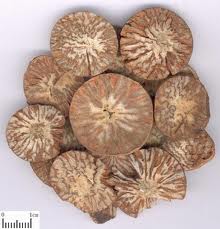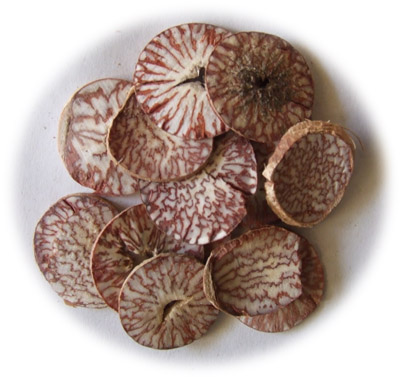Bing Lang


Naming
Bing Lang (Semen Arecae)——Ming Yi Bie Lu (Miscellaneous Records of Famous physicians)
The Processing of Bing Lang
Origin
The dry ripe seed of the evergreen tree Areca catechu L. of family Palmae.
Location
Hainan, Fujian and Yunnan provinces in China.
Harvest
Collected in late spring to early autumn.
The actual smell and taste
Light smell, astringent and light bitter.
Best quality
Large, firm, and heavy with fresh-looking cross section.
Processing
Boiled, dried and peeled, then dried in the sun; sliced after maceration or smashed.
The Effect of Bing Lang
Property
Bitter, pungent, warm; stomach and large intestine meridians entered.
Actions
Expel parasites and promote digestion, move qi, induce diuresis.
Indications
A. Various intestinal parasitic diseases
It can expel and kill a wide variety of intestinal parasites including tapeworm, roundworm, pinworm, hookworm, fasciolopsis and so on and it excels at expelling worm bodies by its purgative action. The ability of its purging down helps in expelling the bodies of parasites, best for treating taeniasis. It could be used singly or combined with herbs to promote flow of qi and alleviate pain, such as Mu Xiang in the formula Sheng Gong San from the book Zheng Zhi Zhun Sheng. It is mutually reinforced by Nan Gua Zi in modern usage. When combined with Shi Jun Zi and Ku Lian Pi, it is reinforced for treating ascariasis and enterobiasis.
B. Indigestion and qi stagnation, diarrhea, dysentery and tenesmus
This herb is pungent and bitter with the actions of dispersing and purging, enters stomach and large intestine meridians, and is good at moving stomach and intestine qi, also purging mild and relaxing bowel, and promoting digestion and removing food stagnation. For indigestion and qi stagnation, abdominal distension and constipation and so on, it is often combined with qi-moving herbs and offensive purgatives. For instance, it is combined with Mu Xiang, Qing Pi, Da Huang and so on in Mu Xiang Bing Lang Wan from Ru Men Shi Qin. For damp-heat diarrhea and dysentery, it is also combined with heat-clearing and damp-drying herbs and qi-moving herbs. For instance, it is combined with Mu Xiang, Huang Lian, Shao Yao and so on in Shao Yao Tang recorded from Bao Ming Ji (Collection of life-protecting).
C. Edema, foot swollen and pain due to downward flow of damp turbidity to the foot
This herb induces diuresis and moves qi that can help move fluid. For edema of excess syndrome and difficulty in urination and defecation, it is reinforced by the combination with qi-moving and diuresis-inducing herbs. For instance, it is combined with Shang Lu, Ze Xie, etc. in Shu Zao Yin Zi from Yan Shi Ji Sheng Fang (Yan's Saving Lives Prescriptions). For cold-dampness induced foot swollen and pain, it is often combined with meridian-warming and cold-dispersing herbs and damp-resolving and qi-moving herbs. For instance, it is combined with Wu Zhu Yu, Mu Gua, Chen Pi, etc. in Ji Ming San from Zheng Zhi Zhun Sheng.
In addition, this herb checks malaria. For malaria it is combined with other malaria-checking herbs such as Chang Shan, Cao Guo, etc.
Dosage and Administrations
Decoct 3~10 g. Take 30~60 g when expelling tapeworm and fasciolopsis. The raw is better than the stir-baked and the fresh is better than the old.
Cautions
It is contraindicated for loose stool due to spleen insufficiency or qi sinking. Use with caution for pregnant women.